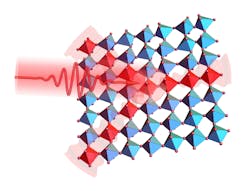Ultrafast electron diffraction at SLAC helps demystify 2D perovskites
A group of researchers led by Aditya Mohite, an associate professor of chemical and biomolecular engineering at Rice University (Houston, TX), set out to solve one of the fundamental photo-physics questions for an emerging soft semiconductor, a 2D perovskite: how does this material respond to light, and is it possible to visualize the dynamic interactions between the lattice and charge carriers?
2D perovskites are currently being widely explored for their potential to create more efficient light harvesters, photodetectors, and light-emitting diodes.
“We know perovskite materials, due to the softness of their lattices, respond to light in unique ways,” says Mohite. “The carrier electrons and holes tend to strongly interact with the soft crystal lattice, compared to conventional well-studied semiconductor materials like silicon or gallium arsenide. Understanding this process will be crucial for the energy transfer mechanism, favoring rational design of efficient light harvesters.”
But a longstanding challenge exists: can these interactions that typically happen at an ultrafast timescale on the order of picoseconds be visualized?
“To achieve this goal, we directly probe the ultrafast structural dynamics in 2D perovskites, using SLAC National Lab’s mega-electron-volt ultrafast electron diffraction (MeV-UED),” says Mohite.
2D perovskites + hot carriers
The group successfully directly visualized the lattice degrees of freedom at an ultrafast timescale and demonstrated ultrafast structural dynamics within single crystalline 2D perovskites.
“We performed our unique experiment at SLAC National Lab because it’s one of the few facilities in the world using high-energy electrons with femtosecond-pulse duration,” says Mohite. “By using MeV-UED, we’re able to capture the subtle and transient change of structural responses in 2D perovskites. And we observed a surprising lattice behavior: a relaxation of lattice distortion initiated by an electron-hole plasma.”
2D perovskites consist of compounds with layered nanostructures that confine the charge carriers within two-dimensional sheets. They have two alternating layers: a perovskite layer confining the charge carriers, and a spacer layer that sandwiches the perovskite layers and insulates the charges.
Being able to relax lattice distortion in 2D perovskites is a big deal because it reveals a unique energy loss mechanism of carriers within the perovskite lattice, which opens the door to future research pathways like hot carrier solar cells.
“Researchers are talking about the concept of hot carrier solar cells, where they try to extract the energy of hot carriers before relaxing their energy within the lattice—leading to efficient light harvesting. All of these concepts require comprehension of the carrier energy loss channels, and understanding such questions requires a direct probe of the lattice to visualize where the energy transfers to,” says Mohite.
Hot carriers correspond to charge carriers carrying very high energies in a semiconductor, and can be generated by light or current. They eventually lose their excess energy to the crystal lattice, mostly as heat. Understanding this type of heat generation and how it’s transported through the materials is important in heat extraction and management of these compact stacking devices.
Ultrafast reduction of lattice distortion
One intriguing aspect of the group’s work was the observation of an ultrafast relaxation of lattice distortion in 2D perovskites in response to light because “it’s a counterintuitive behavior in semiconductors, where an enhanced thermal disorder of atoms is generally expected—it’s known as the Debye-Waller effect,” says Mohite.
But in 2D perovskites, they discovered the lattice gets more energy from just thermal energy and witnessed the crystals become more ordered by relaxing their intrinsic distortions (a.k.a. octahedral tilt; see figure). “This is initiated by a high density of carriers known as an electron-hole plasma, which leads to modification of the cohesive energy of the 2D perovskite lattice,” he adds.
A big challenge for the group was to visualize the ultrafast response of the crystal lattice on the order of picoseconds. “We overcame this by the ultrafast electron diffraction in SLAC, which gives ultrashort electron pulses of femtosecond duration, as well as high kinetic energies of electrons that enable strong interactions with the atoms in the crystals,” Mohite says.
Tunable properties
The researchers are now trying to answer one of the fundamental questions of semiconductor physics under light: how do these carriers dissipate energy into the perovskite lattice? Finding an answer will help them understand the structural dynamics so they can further tailor the chemical compositions and structures as a “tuning knob” to design devices with more efficient energy harvesting.
“Our next step is to demonstrate the tunability of such unique behavior and to tailor these energy transfer properties toward different applications, such as heat management and hot carrier photovoltaics,” says Mohite.
Since 2D perovskites are well known for their tunable physical properties via chemical design, “we’ll systematically study the nature of carrier-lattice interactions with variable physical parameters to understand which of the parameters will be crucial for optimizing our optoelectronic devices for higher efficiency,” he adds.
FURTHER READING
H. Zhang et al., Nat. Phys. (2023); https://doi.org/10.1038/s41567-022-01903-6.
About the Author
Sally Cole Johnson
Editor in Chief
Sally Cole Johnson, Laser Focus World’s editor in chief, is a science and technology journalist who specializes in physics and semiconductors.

